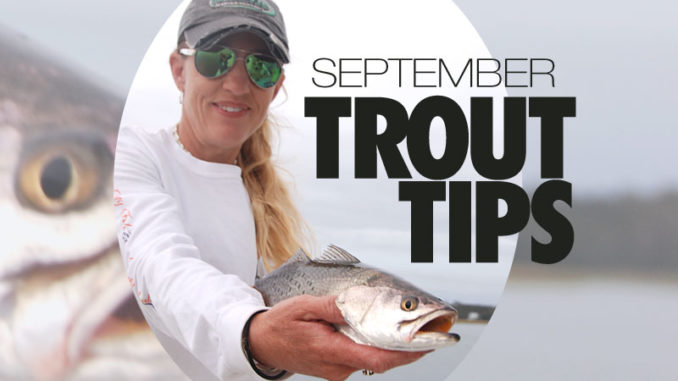
September offers a peek at the fall trout bite
September can be a month of feast or famine when it comes to speckled trout fishing anywhere along the Carolinas’ coastline.
Water temperatures are likely to be in the upper extremes. And there’s plenty of competition from real fish food that’s not carrying a hook in its pocket.
John Boy Koonce of Shoal Bandit Charters in Charleston, S.C., loves what he refers to as “early season” speckled trout fishing. September comes in hot and starts to temper with a promise of what’s to come later.
Koonce takes it all in stride. He’s found a combination of tactics and locations that will put fish in the boat, whether you’re fishing in his native North Carolina or his adopted state of South Carolina.
Go slow, go deep for September speckled trout
“You almost have to fish like it’s the dead of winter,” he said. “That means slow and deep. The good thing is, the fish are not as lethargic. So if you’re in the right spot and presenting the bait properly, it won’t take long for the fish to let you know.”
Koonce (843-425-2939) starts off with his three favorite early season locations to find speckled trout.
Edge of The Grass
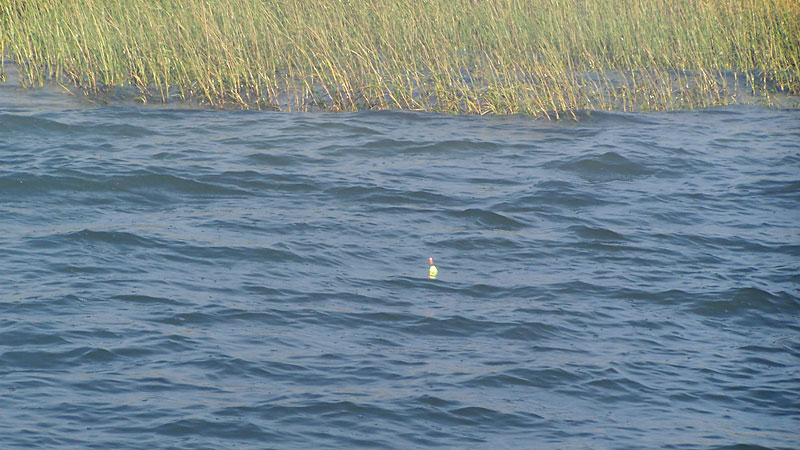
This is a no-brainer for trout fishing year-round. Koonce said he looks for grass edges that have deep water within a cast distance of the grass.
“For trout, 7 to 8 feet is deep,” he said. “Low tide is my favorite. Look for trout pushing bait up against the edge of the channel. But they’ll be near or right off the bottom.
Creek Bends attract trout
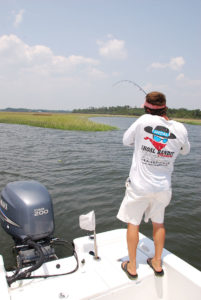
“On a charter, I fish a lot of boat docks, and the best ones will be in the curve of the creek,” he said. “It’s usually the deepest section of the creek, too.”
Another advantage to fishing docks is that any structure nearby or along the channel edge will also hold redfish and flounder.
Intersection Rips
Koonce loves to fish the intersection of a tributary and a main creek on a falling tide. The current creates a seam, or rip current, that’s easy to see. He said in the spring and fall, he focuses on the shallower side. But not this time of year.
“I do better finding trout holding on the deeper side of the rip in the bigger creek,” he said. “The rip will be well defined. But the trout are often off on the deeper side of the current, looking for bait that’s being washed out.”
Incoming water
On a final note about locations, Koonce said the backs of the feeder creeks are going to be way too hot and murky for trout fishing this time of year. His best advice was to find locations closer to incoming offshore water.
“The offshore water is going to be cooler and cleaner. And that’s what you want,” he said. “Trout are sight feeders. And that cooler water gets them stirred up.”
Having defined the spots he wants to fish in September, he turns his focus to how he fishes them.
Popping corks
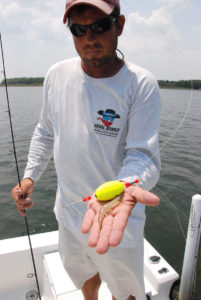
Fishing popping corks for trout is another no-brainer, particularly with live bait. But Koonce may make his leader incredibly long: 5 to 6 feet. While it does make the rig more cumbersome to cast and reduces casting accuracy, it gets down to the fish.
“I’ll put a couple of extra split-shot on the leader to get the bait down and lob it upcurrent of what I’m fishing and just let the current take it down,” he said. “There’s not a lot of popping going on. I’d rather the bait just skip or drift along the bottom.”
Carolina-Rigging
The secret to Carolina-rigging for speckled trout is to use the lightest weight you can get away with. Koonce said usually, this would be a ½- or 3/8-ounce egg sinker. In some cases, he may simply crimp a big split-shot of the same weight class on his main braided line just ahead of a 24-inch monofilament leader.
“I love Kahle hooks and mud minnows for Carolina-rigging,” he said. “Again, you might catch anything — which most of my clients don’t mind. But it also puts that minnow right off the bottom, and all you have to do is bump the weight back to the boat.”
Slow-Rolling Jigheads
Taken right out of his winter playbook, Koonce said when he has identified a spot that’s holding trout, he’ll anchor up and throw a Z-Man GrubZ in pearl blue on a ¼-ounce Eye Strike jighead.
“This is classic trout fishing,” he said. “Throw the bait, let it sink and just ease it back across the bottom. If you get a hit on the fall, then you know to start reeling a little sooner or a little faster. But the basic retrieve is low and slow all the way back to the boat.”
Extra opportunities
Guide Aaron Beatson loves to wade for speckled trout on North Carolina’s northern Outer Banks. It’s a great way to stay cool as well as target some pretty decent trout.
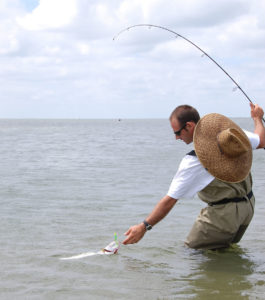
Beatson, who lives in Kitty Hawk, N.C., said the best areas to wade will be on the outer edges of flats where a channel or cut allows trout to move up on the flats to feed and hunt along the edge of the flat. Wading and live-bait fishing don’t exactly go together without extra hassle. So the standard soft plastics and 1/8- to ¼-ounce jigheads are standard fare, along with popping corks.
Beatson (252-256-8083) advises to be on the lookout for slick spots on the flats.
“To me, it smells like watermelon,” he said. “If you have a little chop and you see a flat, oily looking area, it could be bigger fish, trout, attacking baitfish. And they’ll leave behind an oil slick that smells like watermelon. It really stands out on the water once you know what to look for.”
Walk the dog for September trout
Don’t overlook topwater walking baits, especially early and late in the day or under other low-light conditions.
Guide John Koonce of Charleston, S.C., said rock jetties can also be a September hotspot for speckled trout. He cautions anglers to avoid the natural tendency to fish right up against the rocks.
“While the water is still hot, the bluefish and trash fish will be up in the rocks, and they’ll hit the bait before the trout,” he said. “I find that trout like to hang off to the side and a little deeper on the rocks.”
Koonce said the best presentation for target jetty trout would be to line up on the rips formed by either incoming or outgoing tides and cast parallel to the rocks on the deeper side.
Drifting live bait under a popping cork or slow-rolling a soft-plastic bait on a jighead are his preferred methods of fishing jetties.
Koonce said he sees a lot of glass minnows schooling along jetties and does his best to imitate that prey with his lures, using a smaller, silver or opaque plastic bait to try and match the hatch.
If he’s using live bait, he usually finds large schools of menhaden somewhere between the launch and the jetties and will catch a tank full of them in a cast net on the way out. He said most of the menhaden may be too big for anything but really large trout, so he tries to pick out the smallest menhaden he can find from the tank.





Be the first to comment